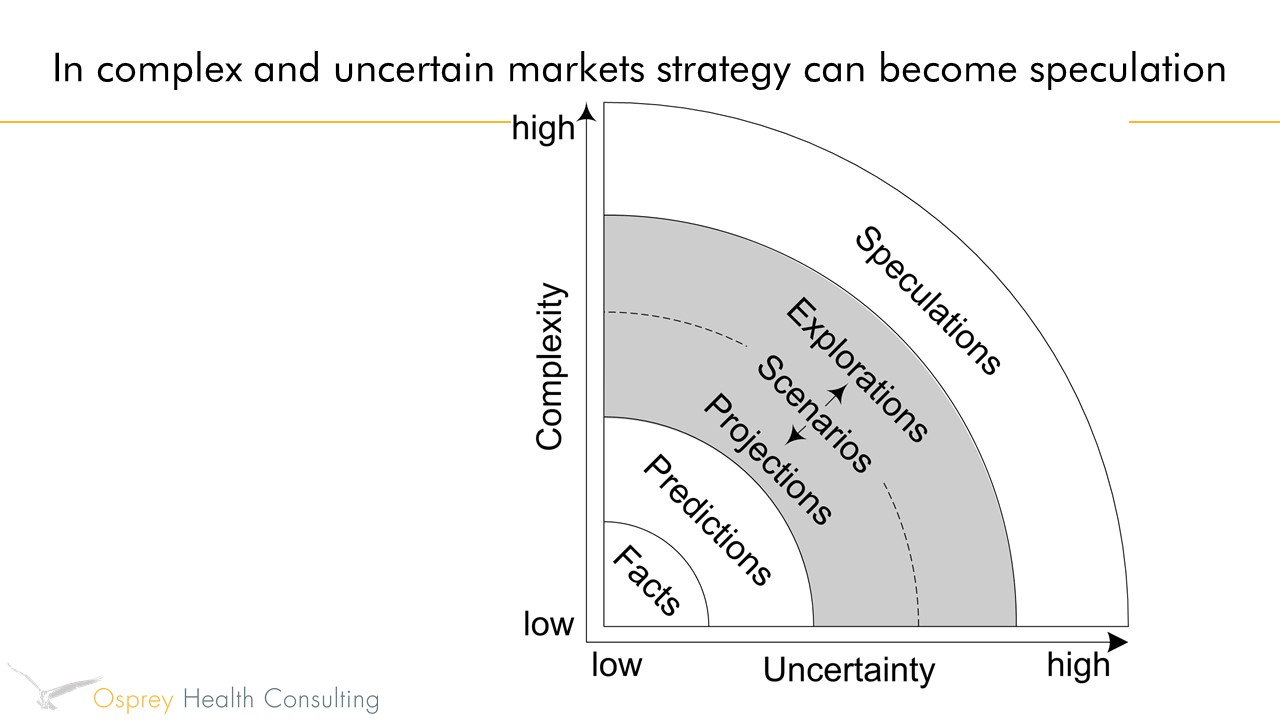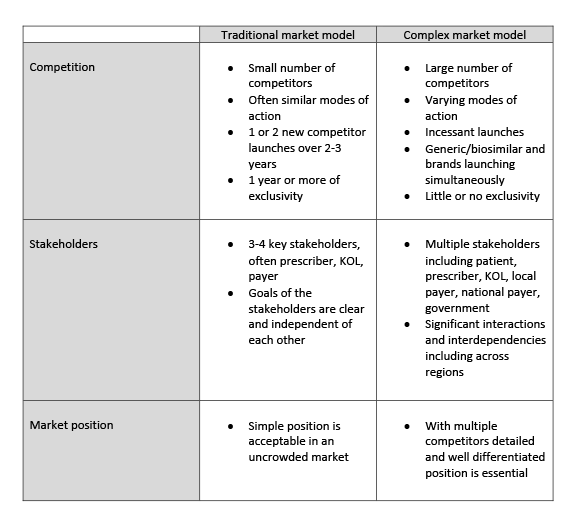Strategic planning in increasingly complex and uncertain markets, the David Cassidy dilemma

This article is the first in a series of three from Osprey Health Consulting that address the contemporary challenges facing strategic brand planners dealing with increasingly complex and uncertain markets. Traditional approaches and methodologies to both long range strategic planning and shorter-term operational brand planning may not provide the means to fully address modern complexity and uncertainty; adaptation is required to provide the accuracy and effectiveness needed to inform critical business decisions. In three concise articles we cannot cover all the topics that deserve mention. However, we will try to convince the reader that only a different approach to planning will deliver the accuracy required to win in the future.
This first article addresses the challenges faced by the strategic planner. Articles 2 and 3 will address the particular challenges faced by the brand planner.
Strategic planning in increasingly complex and uncertain markets, the David Cassidy dilemma
In 1972 the pop star David Cassidy spoke eloquently about the dilemma facing today’s strategists in one of his many hit songs;
“How can I be sure, in a world that’s constantly changing?”
If we don’t want to accept the musings of a teenage pop idol about strategy we may prefer the view of Peter Drucker, the renowned management guru and the author of The Effective Executive, that “All we know about the future is that it will be different from today”.
Therein lies the challenge every strategist has faced since we started thinking about how we might influence and deal with the future. Strategic planning has always been about bringing a thoughtfully envisioned future into the present so that we can do something about it. We make assumptions about what the future will look like and how important groups of people will behave. These assumptions provide the framework within which we create our vision of the future.
Despite often characterising the future vision in great detail and bringing it to life, it remains a fiction and the future will never be exactly as we predict; the variety of possible futures is as vast as the variety in the assumptions you make. If the assumptions have greater variability, so will the potential futures.
Today’s strategic approach is not working
Today, the strategic approach that has traditionally been used is losing its utility. Creating one vision of the future and using it to create strategy has, in many markets, become an inefficient and ineffective way of defining what one needs to do to create success. This is due to increasingly complex and uncertain markets, leading to a growing range of assumptions made around critical market aspects, that together lead to vastly different futures. The more assumptions you have to make (complexity) and the potential variability of the assumptions (uncertainty) makes basing your strategy on a single view of the future a high-risk approach.
In healthcare markets, and perhaps especially in pharmaceutical markets, the number of factors requiring consideration when developing assumptions has increased significantly over the last 10-15 years. Today we have more assets in play, more stakeholders, more scientifically diverse brands, more conflicting needs, and more interactions and interdependencies than ever before. Clever strategists can, of course, help understand which topics are critical and reduce the number of considerations in play. Nevertheless, simplifying things too much is a danger and can potentially hide the complexity and uncertainty you need to deal with.
[caption id="attachment_48411" align="aligncenter" width="1280"] Figure 1[/caption]
Figure 1[/caption]
Figure 1 captures this concept. With increasing complexity and uncertainty strategic decisions can become more speculative, inaccurate and inefficient. New approaches are required to reduce the uncertainty and to understand the impact of complexity and to recapture the ability of the strategist to make reasonably accurate predictions about the future. Factual prediction remains the unreachable goal, and our predictions must be monitored to ensure their variation from future fact is acceptably low. Table 1 provides a brief overview of how pharmaceutical markets are changing.
Table 1
The increasing complexity of pharmaceutical markets

Of course, it has always been the case that assumptions may vary in strategic planning. However, what has changed is that the increasing complexity of markets has made the variation of assumptions so great that a single vision of the future can not capture all the important future possibilities. The Cone of Uncertainty concept explains this well, describing how future uncertainty has reached a level where a single set of assumptions are unable to capture all the potential important futures. We call this Unacceptable Uncertainty.
The Cone of Uncertainty, where the cone is the breadth of the strategic plan and the coloured circles represent the possible futures. However broad the strategy is, in complex and uncertain markets, it can not cover all possible futures.
[caption id="attachment_48390" align="aligncenter" width="1280"] Figure 2[/caption]
Figure 2[/caption]
The strategist’s dilemma
The strategist is left with the same dilemma as David Cassidy. They want a clear vision; a single, well described and easy to understand plan that includes clear actions to be implemented. However, one plan doesn’t address all the things that need to be dealt with and the strategist feels they need to have additional elements of their plan that cover all (or at least the most important) issues that lie outside their plan. This can lead to too broad a plan which drives an ineffective use of resources and/or a plan that is unclear and not effectively implemented. Their goal is to reverse the cone of uncertainty over time, a concept we use in our planning work.
What senior managers want from a strategy
In a recent August 2018 article, the team at the McKinsey organisation talked with senior leaders in a number of pharmaceutical companies. Much of what was said can be directly linked to increasing uncertainty about the future. The need for rapid response teams, early warning systems to warn of new things happening, planning for the unexpected, thinking more about the competition and integrated decision making are clearly calls to reduce uncertainty or to prepare for the unexpected.
The modern strategist wants to address these challenges and recognises the need to adapt how they deal with the future so they can continue to deliver a clear plan that accurately informs and guides colleagues while providing flexibility to deal with variations in the future and a comprehensive approach to all important likely futures.
This is no doubt why, in our experience, the planning concepts of assessing assumption variability, scenario planning (in various methodologies) and triggered strategies are increasingly attractive to the strategic planners we interact with. They remove the dependence on one future, provide a clear understanding of the impact of varying assumptions and allow the planner to deliver the modern clear, flexible and efficient strategic plan.
[caption id="attachment_48397" align="alignnone" width="1280"] Figure 3[/caption]
Figure 3[/caption]
Assumption variability assessment supports the strategist in understanding the likely impact of varying assumptions on the planning process; it indicates the extremes of assumptions and the level of certainty one has about a particular assumption. As the simple example below shows this can be visualised in a dashboard that explains the assumptions and derives implications. However one does it, the output is an understanding of where uncertainty impacts the strategic plan and what the organisation is going to do to address it. Figure 3 provides a simple schematic of the concept.
Real-time data
Before we move further, we want to raise an important topic. An increasingly important way of dealing with uncertainty is to ensure that the drivers identified and the assumptions created, and their variability, are based in a deep and detailed understanding of what is really happening, or is likely to happen, in a market. This means competitor intelligence, KOL research, and all forms of market tracking are essential prerequisites in creating accurate market drivers and assumptions. Furthermore, as we will see later, the importance of “Real-Time” information, perhaps especially about competitors, has become a critical part of the planning process. This means that the Competitive Intelligence (CI) team and other providers of “Real-Time” information must be integrated into the planning process so they can understand the data that is required and interpret the likely implications of the information they capture. Understanding the landscape in detail has never been more important in strategic planning than it is today. A basic understanding of market dynamics is not sufficient.
Scenario planning as a tool to address complexity and uncertainty
There are a number of methodologies that incorporate scenario planning, and the choice of methodology is often based on the number of varying assumptions one defines. Some methods work well with 2 critical varying assumptions, and others when there are more.
Regardless of methodology, scenario planning delivers a number of future visions based on flexing assumptions as a logical next step after a detailed uncertainty assessment has been made. This is a simple concept. However, implementing scenario planning takes time and considerable effort. Data gathering, pressure testing, understanding interactions and interdependencies and developing detailed characterisations of scenarios are inevitably time consuming. Nevertheless, it is well worth the effort.
A well executed scenario planning exercise will provide critical insights into how markets may evolve, what the common elements are that exist in all, or most, futures and what the specific and important elements are in specific futures AND how important they may be. This concept is illustrated in figure 4.
[caption id="attachment_48392" align="aligncenter" width="1280"] Figure 4[/caption]
Figure 4[/caption]
This helps the strategist enormously. Now they can develop a core plan that is valid regardless of the exact details of the future, and they can explain what additional futures might occur, why they might occur and what the organisation should do if the market develops in a particular direction. Through this process the problem of relying on one vision of the future is solved. No longer is the strategist aligned with one intractable view of the future. They have flexibility and clarity.
The process can also be described as creating a core strategy that is fixed (though it needs to be monitored), and provides the whole strategy over the near term, with future non-core strategies triggered by market-based information. Figure 5 provides a visual interpretation of this concept.
[caption id="attachment_48391" align="aligncenter" width="1280"] Figure 5[/caption]
Figure 5[/caption]
Real time, right now
This brings us back to the critical need for “Real time” information about the market. In the scenario planning process, the strategist will have identified the triggers that indicate the future will travel along a certain path. These are fundamentally IF-THEN statements; if something happens in the market then we will implement a particular strategy. Therefore, the need to monitor markets to identify signs of the IF is an essential part of the strategic planning process. Involving the data gatherers, and especially the CI team, in understanding what they are looking for (it might be a pricing decision, it might be KOL activity, it might be competitor strategy or activity….) and the implications of what they find is an important part of having an effective scenario planning process.
One of the useful elements of the IF-THEN statements is that they may apply at a regional and local level. For example, IF a competitor markets a drug traditionally used in secondary care in primary care THEN we will implement a strategy that drives patients directly to secondary care without visiting primary care, is a triggered future strategy that may only apply in certain countries, or certain market archetypes where “Real-Time” information shows us that a competitor is launching into primary care. This makes the planning process both helpfully specific and efficient, resources only being used when there is clear evidence of the need for a strategy to be implemented.
Furthermore, this approach provides clarity about strategic decisions, defining the IF-THEN statements that are in addition to the core strategy. Regional and local leadership teams will have transparency about which IF-THEN statements apply to them, and what they should monitor and do about them. Clarity and transparency are not only restored to the plan, additional elements of regional and local flexibility are provided that may enhance local involvement with and buy-in to the plan.
An answer to David Cassidy and the strategists’ dilemma
In increasingly complex and uncertain markets how do we respond to David Cassidy’s question, “How can I be sure?”
We can not provide David with absolute surety. However, we can offer him a clear view of the likely future and transparency about the important variations that might occur and what we can do about them. We can provide direction and the means to constantly and accurately measure what is really happening so that we can respond effectively, efficiently and appropriately to the future as it emerges.
We can’t say whether David Cassidy would have been satisfied with this answer. However, we know that it addresses the key issues about the future raised by senior managers across a number of large pharma and biotech companies. Perhaps these senior managers will accept this as being more important.
Scenario planning is not a new concept. It has “Come of age” in healthcare and is likely to be increasingly utilised by strategic planners pushing for accuracy and clarity for their vision of the future. Implementation is not easy, and the effort applied will reap rewards in greater success.
For further reading we recommend The Art of The Long View – Planning for The Future in An Uncertain World, by Peter Schwartz, 1991, Bantam Doubleday. This is a seminal work on scenario planning.
About the authors
The three articles were written by the team at Osprey Health Consulting, a strategy firm specialising in and passionate about strategic planning and brand planning. We would like to hear your comments on this article. Please contact Osprey Health Consulting through; chris.stevenson@ospreyhealthconsulting.com












